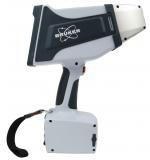
Bruker Corporation, a technology leader in hand-held, mobile and portable (HMP) metals and alloy analyzers, today introduces the new EOS500 hand-held Laser Induced Breakdown Spectrometer (HH-LIBS). The EOS 500 is designed for high-speed analysis of Grade ID and chemistry in light element alloys containing Li, Mg, Al or Si. Speed, accuracy and repeatability are all attributes of the EOS 500. Compared with hand-held XRF, light element analysis with the EOS 500 is approximately 10x faster.
This Smart News Release features multimedia. View the full release here: http://www.businesswire.com/news/home/20151001005088/en/

Bruker Launches Hand-held LIBS for Light Element Alloy Scrap Sorting (Photo: Business Wire)
The EOS 500, suited for Quality Assurance (QA), metal fabrication and Positive Material Identification (PMI), was engineered for durability in the demanding conditions associated with the scrap recycling industry. The rugged design ensures that the EOS 500 will withstand field operation in nearly all environments, including humid and dusty conditions. In addition, the EOS 500 has a unique “Air-Flow Optics Shield”, which creates a continuous air shield in front of the optics in order to prevent dust build-up and to allow the EOS 500 to operate in the most demanding environments.
The EOS 500 uses a proprietary 1064 nm laser for low background laser ablation atomic emission spectroscopy. Traditional LIBS systems utilize a high energy, low frequency laser design for plasma generation, which results in high background noise, especially in the lower end of spectrum. Bruker’s 1064 nm laser generates strong atomic emission signals without creating high background emissions, hence eliminating the need for a complicated gating system. Utilizing this unique design, Bruker’s EOS 500 can easily analyze challenging elements, such as Si and Mg, at <0.1% concentration levels within seconds.
A multi-detector design allows the EOS 500 to cover an extended wavelength range from 170 nm to 720 nm, while maintaining outstanding resolution for a complicated metal matrix such as titanium. This broad wavelength range allows the detection of elements such as Li, Be, Cs, etc., which a single detector could not cover. In addition, the extensive wave-length range also allows the EOS 500 to utilize alternative wavelengths and hence achieve better accuracy by avoiding spectrum overlap.
"Advances in laser technology have enabled the miniaturization and portability of LIBS, which we have now commercialized in the EOS 500," commented John Landefeld, General Manager of the Bruker Nano Analytics division's HMP business unit. "Bruker moved quickly to provide this new hand-held system to our customers, enabling them to work faster and more profitably. LIBS analysis has an important place in metals industries, as a complementary technique to hand-held XRF."
Each technique has advantages measuring certain elements and certain types of alloys. HH-LIBS is well suited to rapidly measuring the low atomic number elements like the alkaline (Li, Na, etc.) and alkaline-earth metals (Be, Mg, Si, etc.), but is not as well suited to measuring high atomic number elements such as the refractory elements (Nb, Mo, W, etc.). HH-XRF, on the other hand, is well suited to measuring high atomic number elements but is not well suited to measuring low atomic number elements like Mg, Al, Si. This makes HH-LIBS the preferable technique for light alloys such as Mg, Al and Ti alloys, while HH-XRF is the superior technique for measuring alloys like stainless steel and high temperature alloys. Customers in the metals industry can now choose the optimal hand-held measurement tool for each application.
Please contact us for additional information on the new EOS 500: www.bruker.com/eos
For more information on handheld XRF, please visit www.bruker.com/hhxrf
About Bruker Corporation (NASDAQ: BRKR)
For more than 50 years, Bruker has enabled scientists to make breakthrough discoveries and develop new applications that improve the quality of human life. Bruker’s high-performance scientific research instruments and high-value analytical solutions enable scientists to explore life and materials at molecular, cellular and microscopic levels.
In close cooperation with our customers, Bruker is enabling innovation, productivity and customer success in life science molecular research, in applied and pharma applications, in microscopy, nano-analysis and industrial applications, as well as in cell biology, preclinical imaging, clinical research, microbiology and molecular diagnostics. For more information, please visit www.bruker.com.
For more information on Bruker, please visit www.bruker.com
View source version on businesswire.com: http://www.businesswire.com/news/home/20151001005088/en/
Contacts:
Bruker Nano Analytics Division
Jerry
Sooter, +1 509-783-9850
Marketing Manager
jerry.sooter@bruker.com
